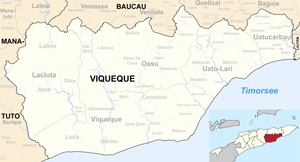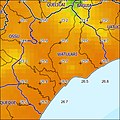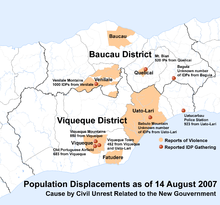Uato-Lari (Administrative Office)
| Uato-Lari administrative office | ||

|
||
|
|
||
| Administrative headquarters | Uato-Lari | |
| surface | 287.94 km² | |
| population | 18,908 (2015) | |
| Sucos | Population (2015) | |
| Afaloicai | 3,980 | |
| Babulo | 2,187 | |
| Macadique | 5,391 | |
| Matahoi | 4,492 | |
| Uaitame | 1,339 | |
| Vessoru | 1,519 | |
| Overview map | ||

|
||
Uato-Lari ( Watu-Lari, Watulari, Hato-Lari, Uatolari, Uatolári, Uatulari, Uatu-Lari ) is an East Timorese administrative office ( Portuguese Posto Administrativo ) in the municipality of Viqueque .
geography
The administrative office of Uato-Lari is located in the east of the municipality of Viqueque on the Timor Sea . In the west it borders on the administrative offices of Viqueque and Ossu , in the north on the municipality of Baucau and in the east on the administrative office of Uatucarbau . The river Bebui flows through the administrative office before flowing into the Timor Sea at Uaitame . Uato-Lari is located south of the Matebians and other mountains to the east, which extend into a fertile hill country in a wide coastal plain. Until the 1960s, the local population only lived in the hills to avoid malaria in the partly swampy plain.
Until 2014, the administrative offices were still referred to as sub-districts . Before the 2015 territorial reform, Uato-Lari had an area of 294.13 km². Now there are 287.94 km².
Uato-Lari is divided into six Sucos : Afaloicai , Babulo ( Babolu ) Macadique , Matahoi ( Mata Ohio ), Uaitame and Vessoru .
Since the Indonesian occupation, the administrative headquarters have been in Matahoi in the town of Uato-Lari . Before that, he was in Uato-Lari (also Uato-Lari Leten ) in the Suco Babulo since the first half of the 20th century .
- Climate data
Residents
The administrative office Uato-Lari has 18,908 inhabitants (2015), of which 9,461 are men and 9,447 women. The population density is 65.7 inhabitants / km². The largest language group are the speakers of the national language Makasae . Around the place Uato-Lari is spoken Naueti , which is one of the Kawaimina languages. The average age is 18.2 years (2010, 2004: 19.4 years). Both the Naueti and the Makasae, who immigrated peacefully from the central mountains over time, follow the same system of alliance building through marriage. There is a certain mixture of the two ethnic groups, in some villages Naueti and Makasae are used as mother tongues at the same time.
history
There is only oral tradition of local pre-colonial history. The Portuguese only established a permanent presence in the region in the 20th century. Accordingly, the kingdom of Babulo the Naueti was the dominant power. It was in conflict with the empire of Builo . The Portuguese colonial power finally dispatched Tomas dos Reis Amaral, a descendant of the ruling family of Luca, as ruler of Uaitame and Vessoru in the mid-1910s, and placed him hierarchically above the ruler of Babulo as administrator of Uato-Lari. The ruler from Luca put an end to the conflict. Other Makasae immigrated to Uato-Lari and Uatucarbau in several waves from the 1930s onwards. Accordingly, descendants of Makasae immigrants from Luca live on the coast to the west and east of the Naueti centers of Babulos and Vessorus.
Since 1942/1945 the region has repeatedly been a place of unrest and violent rioting (1959, 1975, 1999 , 2006, 2007). At first sight it is about political disputes, but over the decades the conflict has become independent and is complicated by generations of hostility. So far, the state government and local leadership have failed to mediate in the conflict.
When the Japanese occupied the region in 1943, the colonial administration was still young and Christianization was not yet far advanced. Uato-Lari suffered from the consequences of the fighting between the Japanese army and Australian guerrilla units in the mountains and hills. The Japanese demanded support from local leaders and forced entire villages to build roads, for example. Others supported the Allied soldiers, so that animosities arose between the clans that can still be felt decades later. After the end of the war, the Portuguese severely punished “collaboration” with the Japanese, which led to resentment against the colonial administration among some local nobles.
In 1959, Uato-Lari was the starting point for the Viqueque Rebellion , one of the last great rebellions against Portuguese colonial rule, which quickly spread to neighboring areas. After the rebels were defeated in Baguia , they withdrew to Uato-Lari and Uatucarbau. Here they were finally defeated by Portuguese auxiliaries from neighboring regions. Seven rebels were executed on June 17th on the river Bebui, the ringleaders banished to Africa until 1968. The rebellion was fueled by Indonesians who had found asylum in Portuguese Timor and then settled in Uato-Lari. It is not clear whether they were Indonesian separatists or agents. After the Viqueque Rebellion, many Naueti lost land and livestock. The Portuguese administration gave it to loyal Timorese, who mainly belonged to the Makasae ethnic group.
Uato-Lari was a retreat for the FALINTIL , who fought against the Indonesian invaders from 1975. Here she founded a Base de apoio , a resistance base that offered refuge for refugees from Ossu, Viqueque, Uato-Lari and Uatucarbau. The base was later destroyed by the Indonesians. At the end of 1976, the Indonesians from Beaco began to invade Uato-Lari.
Between 1976 and 1979 there were massive forced resettlements in Uato-Lari. After the last FALINTIL resistance base at Matebian was destroyed in November 1978, those who had surrendered to the Indonesian occupiers were interned in Uato-Lari. People died here every day. Two weeks later, the internees were transferred to Viqueque on foot or by truck . There were further resettlement camps in Afaloicai (Suco Babulo) and Vessoru at the end of 1979 . Between November 1978 and March 1979 at least 140 people were murdered or disappeared while interned in Uato-Lari. Most of the executions took place in March / April 1979 at various locations in Uato-Lari. Due to the internees and refugees, the number of residents of Uato-Lari rose between 1970 and 1980 from 13,911 to 14,683 by 5.5%. In 1981 several hundred families from Uato-Lari and other parts of Viqueques were deported to Atauro . Many of them died there until the Red Cross began providing aid in 1982. In 1985/86 the deportees were allowed to return to Timor .
During the Indonesian occupation, a large part of these expropriations from the time after the Viqueque rebellion was reversed, so that the Naueti were considered to have profited from the occupation. In the 1999 independence referendum in East Timor , many former rebels and their families supported the solution of autonomy within the Indonesian state. After the decision for independence, many of them moved to West Timor, Indonesia . With the departure of the Indonesians, the ethnic conflicts between the inhabitants of Uato-Lari broke out again. Villages that supported the independence movement (mostly Makasae from Macadique and Matahoi) reclaimed land and property that Naueti had received during the Indonesian occupation. The UNTAET tried to solve the conflict with a "Mediation Council" from June 2000, but progress was slow with the 130 registered disputes. In late October 2002, intergroup violence broke out. Cattle were stolen. Further mediation attempts by the East Timorese government, parliamentarians and various UN missions also remained unsuccessful.
In the election campaign for the presidential and parliamentary elections in East Timor in 2007 , violence escalated again. At the end of March there were clashes between FRETILIN supporters, who mainly belonged to the Makasae, and supporters of the later President José Ramos-Horta and the later Prime Minister Xanana Gusmão . From mid-April the violence increased and several hundred residents of the Naueti villages of Vessoru, Babulo, Afaloicai and Kadilale (Uatucarbau) fled to the hills. Several FRETILIN supporters were then arrested. After Gusmão took office as the new Prime Minister, unrest broke out again in the second week of August among supporters of the defeated FRETILIN. 200 houses were burned down. An unknown number of people fled their homes to Mount Babulo . Over 900 residents of Uato-Lari, mostly Naueti, fled to Uatucarbau, others to the city of Viqueque. Former FRETILIN Prime Minister Marí Alkatiri saw the conflict between Makasae and Naueti as the real cause of the unrest.
After another wave of violence in January 2009, a Nahe biti was held in the city of Viqueque on February 28th , a traditional meeting to reduce tension and reintegrate refugees.
In early July 2010, 95 houses in the village of Aliambata (Suco Babulo) were destroyed by flooding. Chefe de Suco Costodio Silveiro Fernandes called on the government to ensure that those affected are resettled.
After the 2012 presidential elections in East Timor , a house in Uato-Lari was burned down and stones were thrown at a police car in Macadique. On the 10th Independence Day, May 20th, the revelers were ambushed. A 20-year-old was killed and seven houses burned down. Four suspects were arrested. After the parliamentary elections in 2012 , riots broke out in Dili, in which a student from Uato-Lari was shot and killed by a police officer. When his body was brought back home, the Uato-Lari police station was attacked and four police cars were burned.
politics
The administrator of the administrative office is appointed by the central government in Dili. In 2013 it was Anacleto Doutel Sarmento, in 2015 Tomás Soares da Silva.
In 1959 Eduardo Caeiro Rodrigues held the office of mestizo.
economy
52% of households own coconut palms, 59% grow cassava, 58% corn, 49% rice, 44% vegetables and 9% coffee.
Web links
Individual evidence
- ↑ a b c d e Direcção-Geral de Estatística : Results of the 2015 census , accessed on November 23, 2016.
- ↑ a b c Janet Gunter: Communal Conflict in Viqueque and the 'Charged' History of '59 , 8: 1, pp. 27-41, 2007, The Asia Pacific Journal of Anthropology, ISSN 1444-2213 , doi: 10.1080 / 14442210601177977 , P. 29.
- ↑ a b Direcção Nacional de Estatística: 2010 Census Wall Chart (English) ( Memento of the original from August 12, 2011 in the Internet Archive ) Info: The archive link was automatically inserted and not yet checked. Please check the original and archive link according to the instructions and then remove this notice. (PDF; 2.5 MB)
- ↑ Jornal da República : Diploma Ministerial no 24/2014 de 24 de Julho - Orgânica dos Postos Administrativos ( Memento of March 4, 2016 in the Internet Archive )
- ↑ a b Susana Barnes: Origins, Precedence and Social Order in the Domain of Ina Ama Beli Darlari , In: Land and life in Timor-Leste, pp. 33 & 34.
- ↑ a b Seeds of Life
- ↑ Direcção Nacional de Estatística: Census of Population and Housing Atlas 2004 ( Memento of November 13, 2012 in the Internet Archive ) (PDF; 14 MB)
- ^ Susana Barnes: Origins, Precedence and Social Order in the Domain of Ina Ama Beli Darlari . In: Land and life in Timor-Leste. P. 29 & 32.
- ↑ a b c Fundaisaun Mahein: The Everlasting Trouble in Uatulari , April 24, 2012
- ↑ a b c d e f g Ernest Chamberlain: The 1959 Rebellion in East Timor: Unresolved Tensions and an Unwritten History , accessed September 7, 2013.
- ↑ Australian Department of Defense, Patricia Dexter: Historical Analysis of Population Reactions to Stimuli - A case of East Timor ( Memento of September 13, 2007 in the Internet Archive ) (PDF; 1.1 MB)
- ↑ History of Timor ( Memento of the original from March 24, 2009 in the Internet Archive ) Info: The archive link was automatically inserted and not yet checked. Please check the original and archive link according to the instructions and then remove this notice. (PDF; 824 kB) - Technical University of Lisbon
- ↑ a b c "Chapter 7.3 Forced Displacement and Famine" (PDF; 1.3 MB) from the "Chega!" Report of the CAVR (English)
- ^ A b Susana Barnes: Origins, Precedence and Social Order in the Domain of Ina Ama Beli Darlari . In: Land and life in Timor-Leste. P. 35.
- ↑ a b Internal Displacement Monitoring Center ( Memento of the original from September 24, 2011 in the Internet Archive ) Info: The archive link was automatically inserted and not yet checked. Please check the original and archive link according to the instructions and then remove this notice. (PDF; 464 kB)
- ↑ "Chapter 7.2 Unlawful Killings and Enforced Disappearances" ( Memento of the original from March 25, 2016 in the Internet Archive ) Info: The archive link was inserted automatically and has not yet been checked. Please check the original and archive link according to the instructions and then remove this notice. (PDF; 2.5 MB) from the "Chega!" Report by CAVR (English)
- ↑ Secretariado Técnico de Administração Eleitoral STAE: Eleições para Liderança Comunitária 2009 - Resultados ( Memento of August 4, 2010 in the Internet Archive )
- ↑ Televizaun Timor-Leste, July 6, 2010, Ninety five houses destroyed by flood
- ↑ Diario Nacional: One person killed and seven houses set on fire , May 23, 2012.
- ^ East Timor Legal Blogspot: Police officer who shot dead Armindo Pereira Alves suspended , July 20, 2012 , accessed July 21, 2012.
- ^ East Timor Legal Blogspot: Uatulari Police station attacked , July 20, 2012 , accessed July 21, 2012.
- ^ Radio Timor-Leste: PNTL and UN Police cars destroyed in Uatulari , July 20, 2012.
- ↑ Ministério da Administração Estatal: Administração Municipal ( Memento of the original from June 1, 2016 in the Internet Archive ) Info: The archive link has been inserted automatically and has not yet been checked. Please check the original and archive link according to the instructions and then remove this notice.
- ↑ Janet Gunter p. 30.
- ↑ Direcção Nacional de Estatística: Suco Report Volume 4 (English) ( Memento of the original from April 9, 2015 in the Internet Archive ) Info: The archive link was inserted automatically and has not yet been checked. Please check the original and archive link according to the instructions and then remove this notice. (PDF; 9.8 MB)
Coordinates: 8 ° 49 ′ S , 126 ° 32 ′ E






